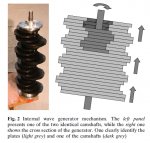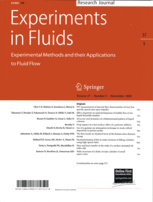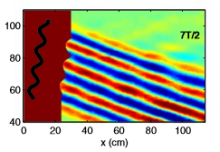We have designed a new kind of internal wave generator
to produce a monochromatic and unidirectional
beam. The idea is to create a boundary with wavy motion made by a set of plates which oscillate with different phases controlled by a camshaft. This system has three advantages. First, the oscillating boundary conditions force the fluid particles to travel in the preferred direction of the wave ray, hence reducing the mixing due to forcing. Second, only one ray tube is produced so that all of the energy is in the beam of interest. Third, temporal and spatial frequency studies emphasize the high quality for temporal and spatial monochromaticity of the emitted beam. The greatest strength of this technique is therefore the ability to produce a large monochromatic and unidirectional beam.

The generator operation is shown in this animation and in real operation in this movie.
The generator consists of a pile of 24 expanded PVC sheets (2x36x150 cm) enclosed in a parallelepiped half-opened box and free to slip one over the other. The plates are weighted with thin lead sheets so that they are buoyantly neutral in water ; it minimizes friction forces between plates. They are thus separated by 2.2 mm one from the other. Two rectangular holes in each plates allow two identical camshafts to go through the pile, imposing the relative position of the plates.

At rest, the plates are sinusoidally shifted, due to the helicoidal repartition of the cams. The rotation of the camshafts applies a periodic motion to the plates which propagates upward (resp. downward) for a clockwise (resp. anti-clockwise) rotation. The eccentricity of the camshafts defines the amplitude of oscillation of the plates, namely 6 cm peak to peak.
To optimize the emission process, the generator is slightly tilted in direction of the emitted beam, i.e. the direction of shear propagation. In the following, we generate a downward propagating beam (defined by the direction of the group velocity) corresponding to an upward propagating shear (direction of the phase velocity). As anticipated, the device can easily generate upward propagating beams.

Reference :
L. Gostiaux, H. Didelle, S. Mercier et T. Dauxois (2007) Experiments in fluids 42, 123.





